Blurred Vision: The Bizzareness of Sonic & All-Stars Racing Transformed
By gamer_152 3 Comments
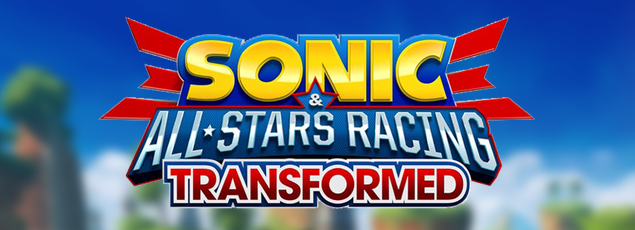
With all the tacky, semi-functional Sonic games that Sega has put out over the last couple of decades, it feels like a given that the Sonic cart racers would be second-rate cash-ins. In comparison to other genres, cart racers are less creative spaces and more ready-made wireframes for studios to paper mache over. What distinguishes them is less often the play and tone, and more often the branding. With lean mechanical profiles and intuitive goals, cart racers are also a good target for more casual and younger audiences in games. They're for both long-time gamers and people who don't want to waste their time learning about complex crafting systems or mastering simultaneous use of the sticks just to spend an evening with some cheerful characters. This is not an inherently bad thing, but take the muddled and often rushed mechanics of the previous Sonics and combine them with a format that is often more about obligation than originality, and you won't give your audience a lot of hope for the final product.
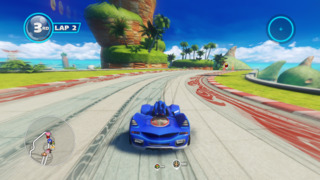
However, Sonic is not just a series known for its slippery hold on quality, but also a long line of inexplicable writing and design quirks. In this case, the unforeseeable twist is that the Sonic cart racers feel smoother and less conflicted than the mainline 3D Sonics. I'm mainly going to talk about the second Sonic driving title: All-Stars Racing Transformed, as it contains most of the mechanics of the first game, and a whole lot more. There's long been a self-contradiction at the heart of this series where the movement model and the play are optimised for speed and blind leaps forward, but the level design frequently demands precision and caution. It's not that you don't slow down in Sonic games, it's that when you do, measured movement often feels skiddy and disagreeable. A physics model made to launch you through vertical loops at a hundred miles an hour is unlikely to be your preferred tool for closing small gaps between individual enemies and platforms.
All-Star Racing adopts the high-velocity physics of the Sonic platformers, but instead of interrupting that whirlwind sprinting every few metres with spikes, pits, and robots, it lets the movement flow with a contiguous track that runs throughout the level. Imagine these same courses with a brick wall to dodge every other second, and you can understand why a conventional Sonic stage can feel so choppy in its pacing. The looping nature of a race track also means that you never have to slow down to double back on yourself, and because there are no precision sections, the designers don't have to moderate your acceleration. Like in other Sonic games, your player character is engineered for constant movement into new space, but unlike in them, there's always more space to move into.
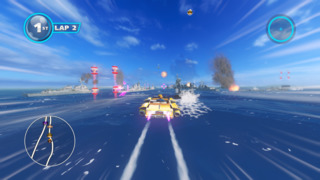
It's also likely that All-Stars Racing was a more manageable development project than any other Sonic game. The trademark hyperspeed of the mainline games means that there are sections of their levels that developers may spend days or weeks sculpting that the player blows through in a matter of seconds. It's an unusually inefficient form of level production for an annualised franchise. However, in All-Stars Racing, levels might fly past your window quickly, but never that quickly. Plus, the multiple laps on each track mean that in a single race, the same section of level can be recycled twice over where a conventional Sonic might need to make an environment twice or three times as long instead.
Like Sonic Generations, the game is also elevated by the fact that the developers can apply many different modes of play to the same stages. When they want the player to have a new experience, they don't have to stretch their resources thin by creating another level; they can drop them back into the same level with an elimination event, a drift challenge, a time trial, or something else entirely. And enemies can behave remarkably different from any one of these races to the next. We sometimes lure ourselves into a pattern of believing that more variety in entertainment software only comes with more content, especially because a lot of companies producing that content would like us to believe that's the case. However, there are plenty of other ways to change up a player's experience which don't involve simply introducing new missions, dialogue, or assets, and when a dev team can find alternatives to doing that, they can spend more time focused on the fundamentals.
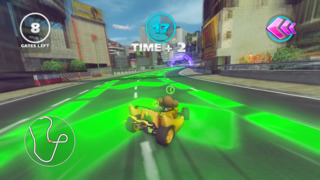
Don't get me wrong, the blue blur's casual racer has its fair share of downer moments. It doesn't sidestep the generic fate of other games in this format, and if you're playing on a higher difficulty, it's hard to predict when a well-aimed projectile will send you careening off-course and ruin the whole race for you. The degree of challenge is also inconsistent between modes. It's easier for a developer to find the perfect waterline for their difficulty when they're looking at two levels in a game that operate on the same ruleset because an enemy or a spike pit in one stage will figure into the play in the same way it will in another. When levels work on different rulesets, it can be tougher to judge the precise effect of any one element in the level in comparison to its effects in other modes. This is especially true when they're going to see a range of different skillsets across their players. For example, some drivers are better at drifting than aiming items, but for others, it's the opposite, so it's hard to come up with "normal" difficulty races and drift courses that are correctly balanced for all of them. It's likely these reasons that mean the difficulty graph of All-Stars Racing Transformed looks like a craggy mountain range.
Lastly, the title is trying to integrate three different kinds of vehicle into its play simultaneously, where a standard racing game would usually only try to incorporate one. And those three steering models don't all deliver the same amount of gratification. They remind me a lot of The Crew 2 which also had events where players would swap between cars, planes, and boats, but in which racing on water just felt like a more sluggish version of racing on land. God help you if you lose your momentum while boating through All-Stars Racing Transformed.
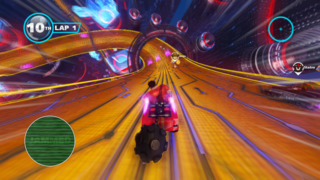
But I'm all about games with matching parts, and in All-Stars Racing Transformed, the big ideas do come together. Where it feels like other Sonic games have been trying to work out how to get a race car to perform parkour, All-Stars Racing has a race car drive down a racecourse. Where previous Sonic games often had ambition beyond the people, money, and time at their back, All-Stars Racing reflects a production capability proportional to the vision behind it. It also responds to one of the most pressing concerns of old-school Sonic fans. There's always been some consternation from the Sonic old guard over Sega abandoning them for a younger audience with different priorities. People who'd known Sonic as a jumble of minimalist 2D platforming increasingly found it a rolling tide of entry-exclusive novelties and childish but vibrant characters. Sega got away from their roots and being into Sonic no longer required just intuiting when to run and jump, but now knowing what the Death Egg was and having some connection to Big the Cat and Silver the Hedgehog. I'm not making a value judgement on that here, but those who'd followed Sonic from the start were less than pleased with this development.
Against all the odds, these cart racers, using a format typically aimed at families and casual gamers, are the most dedicated homages to the console and arcade days of Sega in any Sonic game. You can burn rubber through a temple from Shinobi or take to cobblestone streets as Gilius Thunderhead from Golden Axe. Developer Sumo Digital showed their Skies of Arcadia track to SoA creators Shuntaro Tanaka and Rieko Kodama, and they became overwhelmed with emotion. The studio put so much blood, sweat, and tears into realising locations and drivers that will mean something to only a sliver of Sonic's target audience, and that's how you know it came from people passionate about classic Sega. Not that I doubt plenty of modern Sonic developers get a twinkle in their eye when they think back to Gunstar Heroes on the Genesis, but they're typically unallowed to express that kind of feeling. At most, Sonic can be referential to Sonic; at worst, he must always be putting distance between himself and his point of origin in service of the brand.
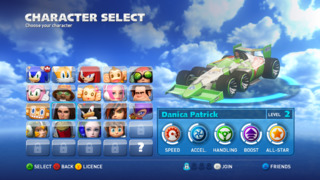
We've talked about the consistencies in the design and the respect for classic Sega, but I know what people come to a Sonic game to see: bewildering absurdity, and don't worry, Sonic & All-Stars Racing Transformed has that too. Perhaps most famously, in its inclusion of former NASCAR driver Danica Patrick; you have a real-world sports personality kicking it alongside zany cartoon hedgehogs. Of course, all the characters in All-Stars Racing have cheeky quips like "Gotta go fast" or "Too slow", so the developers were forced to shoehorn in some manufactured Patrick catchphrases like "No black flag here" or "There's the rub" as if she was an after-school cartoon character. Patrick designed her own car for the game, one which is essentially a Hot Wheels toy and is called, I kid you not, "the Danicar". Additionally, she appeared in one of Archie Comics' Sonic graphic novels to promote All-Stars Racing Transformed. It's not unlike when David Beckham showed up on that episode of Sesame Street but more like if Beckham was also one of the puppets.
But it's not just Patrick making a bizarre cameo in this game. The inclusion of Wreck-It-Ralph means that there's a universe where B.D. Joe from Crazy Taxi and Ulala from Space Channel 5 have met a Disney character. As the outlet Poison Mushroom notes, Sega has published reputable Disney games in the past, so the companies aren't worlds apart. Still, nothing can take away from how weird it is to have a cartoonified John C. Reily appear in a Sonic title. The PC version also lets players race as Team Fortress 2 characters, roll around in an oversized football as "Football Manager" who Sega has weirdly conceptualised as a single character, or play as Rome II: Total War's murderous general, Willemus. Again, all ripping up the asphalt alongside harmless childhood companions like Amy Rose and Shadow.
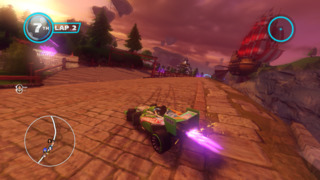
Nintendo created giddy and joyful recombinations of their games through plucking characters from different series and pitting them against each other in releases like Super Smash Bros. and Mario Kart 8. Pretenders like PlayStation All-Stars and Sonic All-Stars Racing use the same technique but with more jarring results. Because, while Nintendo almost always designs their characters in the same soft, caricatured art style, other companies tend to freewheel between realistic and abstract character styles that don't fit side by side. But the weirdest is yet to come.
You may be familiar with the YouTube gaming show Yogscast. Charity-funding DLC lets you play as YouTuber Simon Lane in All-Stars Racing Transformed, but the game only acknowledges him as "Yogscast". Imagine if they added Brad Shoemaker to the roster, but the developers only ever acknowledged him as "Giant Bomb"; that's about what happened. You're probably noticing by this point that many of the characters in this game got there because of a collaboration between Sega and outside parties. Generally, the character selection in All-Stars Racing Transformed has more to do with finding fan favourites than it does with sticking to a theme. On which note, there was a minor fan campaign to make Sega include NiGHTS from Nights into Dreams in Sonic Racing. It used the name "Don't Forget NiGHTS", and sure enough, All-Stars Racing Transformed does open its doors to the dream warrior, even if it wasn't solely as a response to that community effort. The disturbing part is that, unlike the other characters, NiGHTS doesn't drive a vehicle. In a monstrous display of body horror that could have been ripped right out of Hellraiser, NiGHTS has been morphed into the shape of a car, and she's driven by a "Nightopian".
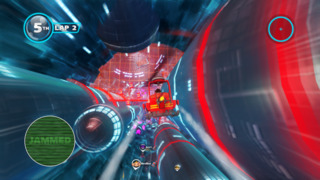
Finally, if you truly do not value your free time, you can unlock "AGES", a combination of three classic pieces of technology from Sega games into one "character". On land, AGES takes the form of one of the cars from Daytona USA, but put it into the water, and it reshapes into a huge, mobile Dreamcast controller. Take to the air, and it becomes the real fighter jet, the F-14 Tomcat, a reference to arcade classic After Burner. The existence of the F-14 is why there's a disclaimer on the game's initial loading screen which tells the player that it was not supported by any arms manufacturer just in case you thought Lockheed Martin was taking that sweet animated hedgehog money. Although, this game's blue shell is the "Drone", so if you've ever dreamed of droning Tails, this is the product for you.
With the weird characters also come a few odd maps. All-Star Racing Transformed has its own Rainbow Road doppelganger: Galactic Parade; it also has Temple Trouble, a level where you crest a hill, and a giant, terrifying monkey head stares over the horizon at you. My favourite twist in the game comes right at the end. Every track is based around a game like Samba de Amigo or Jet Set Radio, but the final one you unlock is attributed to "Sonic & All-Stars Racing Transformed". In an unapologetic act of self-reference, Sega made the final boss postmodernism. After you beat that course, you get a credit sequence which sweeps over some of the locations from the game and includes a picture-in-picture which shows you the exact same camera shots overlayed on themselves. It's a wild choice.
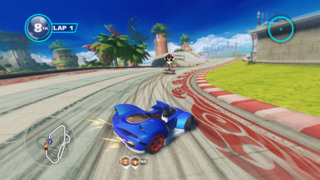
Roughly half of what I've talked about in this article is trivia. It's not the most consequential content in any game, but it's fascinating in its confusion, and it's made me realise why I compulsively come back to this series. I keep dropping in on my old pal Sonic because I want a game that delivers on that promise of velocity and unhindered movement through colourful locales. Because I wish that Sonic's level and enemy design accommodated that desire for speed as well as the level and enemy design in All-Stars Racing Transformed does. But I also can't quit Sonic because no other series makes baffling left-field decisions the same way Sega's flagship platformer does. A lot of games have misjudged writing or identity crises, but from its tone-deaf use of characters to its one-off gimmicks, few other games fall apart as curiously and eccentrically as Sonic does. Thanks for reading.